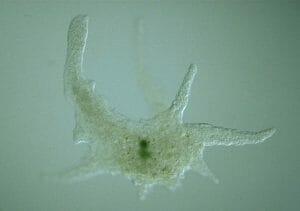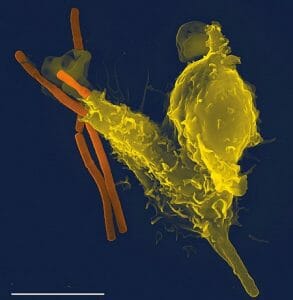Pseudopod Definition
Pseudopod comes from the Greek words pseudes and podos, meaning “false” and “feet” respectively. They are projections of the cytoplasm of unicellular protists or eukaryotic cell membrane. Often formed by the filament structure and microtubule, the surface of the cell projects a membrane in a process called lamellipodium, which is supported by the microfilaments.
So how do pseudopods move themselves? The filaments at the end of the cell then interact with the myosin which produces a contraction resulting in movement. The cytoplasm fills the lamellipodium to form the projections, or the pseudo. These projections extend and contract through the action of the actin polymerization, which pushes the cell forward. Imagine pseudopods as blob-like monsters you see in sci-fi films only they are microscopic and not monstrous at all. They are part of the adaptation of certain animals so that they can move effectively within their environment.
Types of Pseudopod
Pseudopod comes in different shapes and types. In fact, organisms that are capable of producing these projections vary depending on which classification they belong to thus the structure and form of the projections define its taxonomical characteristics thereby making the shapes of the projections unique. To understand further, below are the different types of shapes of pseudopods.
Lobopodia
Lobopodia refer to the finger-shaped pseudopod and is the most common type observed in nature. They are characterized as short, blunt, and bulbous projections that contain both endoplasm and ectoplasm of the organism. An example is the lobose amoebae, which is considered the largest of all pseudopodia.
Filopodia
Characterized by having thin and thread-like pseudopod, filopodia has the ability to branch out or anastomose. They are filiform and slender with pointed ends that are mostly made of ectoplasm. The projections are supported by microfilaments. Examples includeLecithium and Euglypha. Interestingly, this type of filipodia has different variations. For instance, the granulopodia is similar to filopodia but it features a granular structure called extrusomes which specialize in capturing the prey more than providing mobility. Another variation of the granulopodia is the granuloreticulopodia that is a cross between filipodia and reticulopodia. It is common among species of Allogromia, which is a type of unicellular eukaryote.
Reticulopodia
Imagine pseudopodia being used as a means to communicate with other cells. Reticulopodia is a specialized pseudopod that communicates with another pseudopodium, thus creating a network called reticulum. Also called reticulosepseudopodia, they create complex projections wherein the individual pseudopodium fuses with one another to create what looks like irregular nets. This type of pseudopodium also functions in both ingestion of food and locomotion. Examples of reticulose pseudopodia are the Foramineferans.
Axopodia
Axopodia are pseudopods supported by arrays of microtubules. The pseudopodia are enveloped by cytoplasm; thus, it is used most for phagocytosis or ingestion of food particles. Protists from the genus Radiolaria and Heliozoa are examples of this type of pseudopodium.

This image shows a giant amoeba from the genus Chaos with three enormous lobose type pseudopod radially protruding from its body.
Functions of Pseudopod
Pseudopods have two main functions: (1) locomotion and (2) capture of prey or engulfing of food. For instance, amoeba can crawl by extending the cytoplasm and the contraction of the filaments. The pseudopodbulge outward from the edge of the cell to pull in the entire organism as it goes forward.
On the other hand, it is also used in capturing and ingestion of prey. They are also used for ingesting particulate matter while providing mobility during food hunting. It is also necessary for sensing prey nearby which helps organisms like the amoeba to engulf matter through the process of phagocytosis. In this process, the needle projections surround the food particle to create a membrane-enclosed sac that pinches off to create a food vacuole before the food is completely digested.
Examples of Pseudopod
Several genera of the Kingdom Protista use pseudopod for mobility and ingestion. Protists are classified neither plants nor animals and they have distinct characteristics that make them worthy of having their own kingdom reserved for them.
While pseudopods are often classified as characteristics of protists, they are not restricted to such classification. Even cells of higher animal’s form pseudopodia. For instance, the white blood cells of vertebrate animals use pseudopod to ingest foreign particles like bacteria and virus in the process called phagocytosis. Below are examples of pseudopods.
Rhizopods
Pseudopodia is a characteristic of a group of protozoan organisms called rhizopods under the kingdom Protista. They are characterized as eukaryotic cells that rely on pseudopod for mobility. They also use their pseudopod to engulf food particles inside a vacuole. Examples of rhizopods include Amoeba proteus, Entamoeba histolytica, Radiolarians, and Foramineferans. These rhizopods are biologically significant. For instance, skeletons of Foramineferanscomprise most of the chalk and limestone in the planet while Entamoeba histolyticacauses amoebic dysentery.
White blood cells
White blood cells are essential components of our immune system. Also called leukocytes, they help the body fight infection by attacking bacteria, virus, and other pathogenic organisms that invade the body. Phagocytic white blood cells such as monocytes and neutrophils form pseudopod to attack and engulf pathogens. The pseudopod also help white blood cells crawl inside the body like excitable systems. This means that the movement of white blood cells veer towards an area where there are likely to be more white blood cells attacking a specific infection.

This image shows a neutrophil (yellow) attacking the orange-rod anthrax bacteria with its pseudopia.
Related Biology Terms
- Pseudopodium – A single temporary projection from the cell of white blood cells and protozoans that is used for locomotion and feeding.
- Phagocytosis – The ingestion of materials like bacteria, virus and broken cells by amoeboids and phagocytes such as the white blood cells.
- Actin polymerization – This refers to the growth of actin, which is a family of functional proteins that form the microfilaments in eukaryotic cells influences the formation of pseudopod for mobility.
Quiz
1. What is a pseudopod?
A. A type of eukaryotic cell under the kingdom Protista
B. A projection, also dubbed as false feetof the cytoplasm, of both protists and eukaryotic cell membrane
C. A part of the cytoplasm of small organisms
D. An important part of the cell that is responsible for successful cell division.
2. What are the functions of the pseudopodia?
A. Locomotion and phagocytosis
B. Locomotion and defense
C. Phagocytosis and cell division
D. Phagocytosis and cell memory
3. Pseudopodia is only restricted to the amoeboid protozoans.
A. True
B. False
